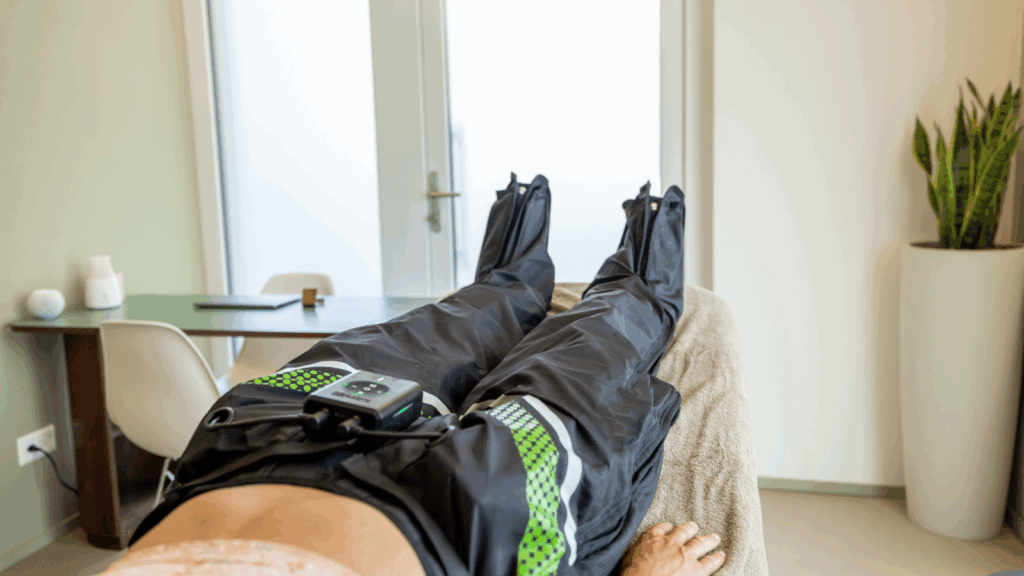Muscle soreness and pain are common after intense physical activity, especially when you push your body to new limits. Whether you’re recovering from a tough workout, training for an event, or dealing with an injury, finding effective ways to relieve muscle discomfort is essential. One of the most effective methods for alleviating muscle soreness is compression therapy.
In this blog, we’ll explore how compression therapy works and how it can help reduce muscle soreness and pain.

What Is Compression Therapy?
Compression therapy involves the use of controlled pressure to stimulate the muscles and tissues. This therapy can be applied through various devices, such as compression garments, sleeves, or boots, that exert consistent pressure on specific areas of the body. The goal is to improve circulation and reduce muscle inflammation, leading to faster recovery and reduced pain.
How Compression Therapy Works
Compression therapy works by applying pressure to the muscles and tissues, which helps to increase blood flow to the affected areas. This increased circulation helps to remove metabolic waste products, such as lactic acid, that build up in muscles after strenuous activity. By flushing out these toxins, compression therapy aids in reducing inflammation and promoting healing.
Additionally, the pressure applied by compression garments helps to support the muscles and tissues, preventing excessive swelling and soreness. The increased blood flow can also deliver more oxygen and nutrients to the muscles, aiding in their repair and recovery.
Reference: merriam-webster.com/dictionary/metabolism
Benefits of Compression Therapy for Muscle Soreness and Pain
1. Improved Circulation
One of the key benefits of compression therapy is its ability to improve blood circulation. By improving circulation, the therapy helps the muscles receive more oxygen and nutrients, promoting quicker healing and reducing muscle fatigue.
2. Reduced Inflammation
Compression therapy helps to limit excessive swelling and inflammation, which are common after intense exercise. By reducing inflammation, the body can recover more quickly, and muscle soreness is lessened.
3. Pain Relief
The gentle pressure from compression garments provides immediate relief to sore muscles. The consistent compression reduces the sensation of pain, making it a useful tool for post-workout recovery or injury rehabilitation.
4. Faster Recovery
Compression therapy accelerates the body’s natural recovery processes. By improving circulation, reducing inflammation, and relieving pain, the therapy helps the body heal more efficiently. This means less downtime between workouts or events, allowing athletes and active individuals to get back to their routines faster.
Who Can Benefit from Compression Therapy?
Compression therapy is beneficial for a wide range of individuals, including:
- Athletes: Athletes who engage in intense training can benefit from compression therapy to help them recover faster and reduce muscle soreness after exercise.
- Fitness Enthusiasts: Individuals who regularly work out or participate in recreational sports can use compression therapy to alleviate soreness and pain from strenuous physical activity.
- People with Injuries: Compression therapy can be helpful for those recovering from muscle injuries or surgeries. It helps to reduce swelling and speeds up the healing process.
- Anyone with Chronic Pain or Inflammation: Individuals suffering from chronic pain conditions, such as arthritis or fibromyalgia, may find relief with compression therapy.
How to Use Compression Therapy
Compression therapy can be incorporated into your post-workout routine or injury recovery process. Here are some tips on how to use it effectively:
- Choose the Right Compression Garment: Compression garments come in various forms, including sleeves, wraps, boots, and socks. Select the type that targets the area of the body where you experience soreness or pain.
- Follow the Instructions: Ensure you use the compression garment according to the manufacturer’s guidelines. Avoid wearing it for extended periods to prevent discomfort or restricted blood flow.
- Combine with Rest and Hydration: For optimal results, pair compression therapy with rest and proper hydration. Giving your body the time it needs to recover is crucial for muscle repair.
Final Thoughts
Compression therapy is an effective, non-invasive method for relieving muscle soreness and pain. It promotes better circulation, reduces inflammation, provides pain relief, and speeds up recovery. Whether you’re an athlete, fitness enthusiast, or recovering from an injury, incorporating compression therapy into your routine can help you feel better and perform at your best.
If you’re interested in learning more about how compression therapy can support your muscle recovery, contact Peake Movement to explore the best options for your needs.
